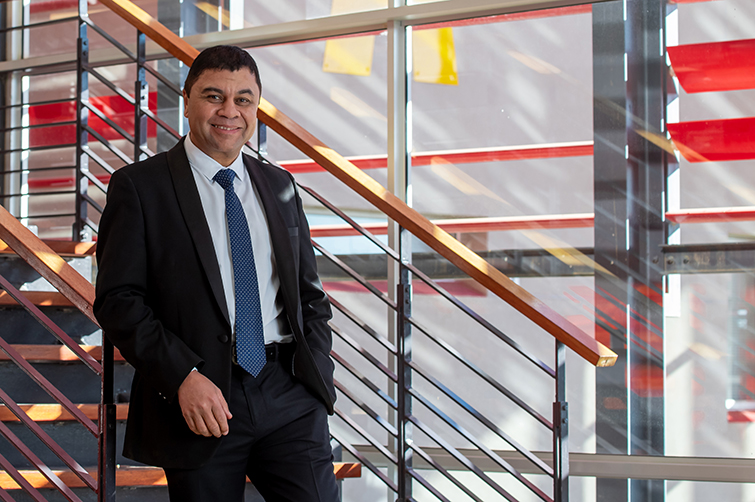09 March 2020
|
Story Prof Francis Petersen
|
Photo Sonia Small
 Professor Francis Petersen is the Rector and Vice-Chancellor of the University of the Free State
Professor Francis Petersen is the Rector and Vice-Chancellor of the University of the Free State
The shortage of skills is a global phenomenon and employers are concerned about the need for skilled professionals to meet the demands of various sectors of their economies. This situation has reached worrying proportions in South Africa, where it has become apparent that there is a nonalignment between the skills graduates are equipped with and those that are required in the workforce.
Moreover, the continuous contraction of the South African economy is further spurring the unemployment crisis: the weak economic performance is not sufficient to create jobs in line with the growth of the working-age population. It is also evident that skills shortages and a lack of social capital have become a systemic problem that prevents access to jobs.
Preparing graduates for the world of work
Unemployment in South Africa is about 29%, according to Statistics South Africa’s latest Quarterly Labour Force Survey; the unemployment rate of people between the ages of 15 and 34 years is 56%. Earlier this month, President Cyril Ramaphosa announced in his State of the Nation address that the country is facing its highest unemployment rate since 2008. Referring to youth unemployment as a “crisis”, the president said about two-thirds of the 1.2-million young people entering the labour market each year remain outside employment, education, or training.
There is an argument that a university graduate should not necessarily be job-ready, but must have the ability to think, to adapt and to learn relatively quickly. Even with this expectation, it is critically important to understand the world of work and to have a relationship with the job market. This is not only important from a future employment perspective, but it will also bring the job market closer to the academic curriculum and the research agenda of the university. It goes a long way towards starting to co-create solutions and conceptualising futures that are more inclusive and sustainable.
UFS interventions to improve student success
The University of the Free State (UFS) has taken collaboration with the private sector, industry, and commerce very seriously — most of the academic departments have industrial or sector-specific advisory boards through which robust discussions are taking place concerning the curriculum, appropriate funding to students, interventions to improve student success, challenges of the job market, and which research projects are essential to tackle. Through these boards, a relationship between the university, industry, the private sector, and commerce is established. This is a good starting point not only to address employment, but also to provide a catalyst for optimising an ecosystem to address the country’s economic challenges.
UFS has also established a Short Learning Programmes office, as we believe that training and retraining workers in an ever-changing job market is essential.
Our proactiveness in creating platforms of engagement with companies about student recruitment — as well as motivating companies, donors, and funders to employ and fund our top graduates — is evident through the work of our Career Services office. Trends in job placement are identified to help us better understand which markets to tailor our programmes to, and to create corporate partnerships for job-training opportunities. Keeping our students informed about career opportunities and equipping them with the skills and grit to make them employable — whether it is to find employment or to start their own business, is the Career Services’ goal.
Developing an entrepreneurial mindset
Entrepreneurship has a vital role in combating unemployment. Equipping students with an entrepreneurial mindset is a priority, and “entrepreneurial thinking” is one of the university’s key graduate attributes.
UFS supports the notion that preparing young jobseekers for the ever-evolving world of work is an integral aspect of their learning at university. We offer a compulsory foundation module to expose all of our first-year students to aspects of entrepreneurship, which are also captured throughout the curriculum.
The UFS Business School has developed initiatives and training programmes specifically aimed at entrepreneurial enterprises. Our Centre for Business Dynamics works with the business sector, helping companies to stay competitive by bridging the gap between existing skills and those required by each industry. Short courses in entrepreneurship are among the tools they use to achieve this. Practical impetus is provided to students with business ideas through our Student Business Incubator; initiatives such as Young Entrepreneurs and the local chapter of Google’s Startup Grind U further stimulate entrepreneurial thinking.
Solving the skills gap
At UFS, we have found that to help the country in solving the skills gap and allow higher education institutions to thrive, various factors, such as industry, region, and job role are important. It has become all too clear that it is not enough to have only technical knowledge — a combination of skills is required for most jobs as technology becomes an integral part of daily tasks in the workplace. Education efforts should focus on areas that set individuals apart from machines and technology.
There is a need for graduates to evolve with career opportunities, as many employers consider critical and strategic thinking skills as fundamental in middle-management roles. Collaboration, negotiation, emotional intelligence, cognitive flexibility, and resilience are important abilities in the workplace.
With the right skills and networks, our graduates will be able to secure employment, have enterprising mindsets to support and sustain themselves, and contribute to the development of their communities.
A strong focus on employability as part of the core business of a university and the ability to equip our graduates with the necessary skills will remain crucial factors in the years to come. Our relationship with industry, the private sector, and commerce is crucial to driving this.
This article was published in the Mail&Guardian newspaper on 6 March 2020